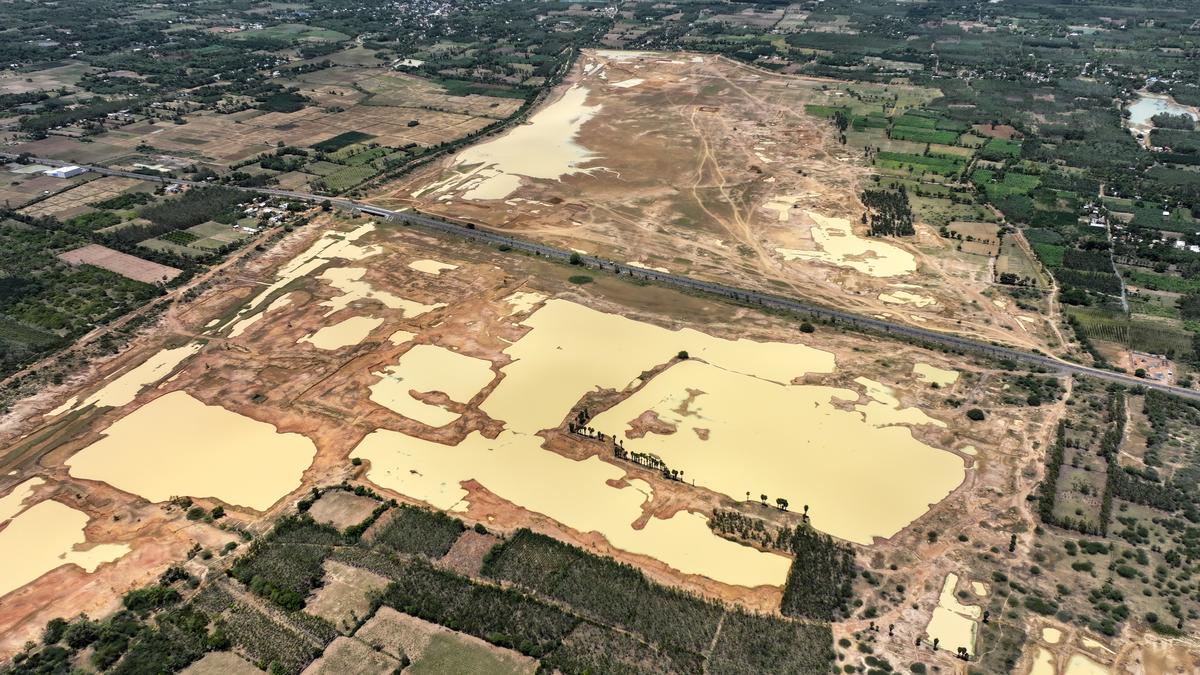Lost its glory: The Ponneri remains dry for most of the year as the canals that once brought water from the Kollidam have long been abandoned.
| Photo Credit: B. JOTHI RAMALINGAM
A few kilometres away from the Brihadisvara Temple at Gangaikonda Cholapuram lies a tank stretching over 17 km. Chola Gangam, locally known as Ponneri, was dug by Rajendra Chola to celebrate his northern campaign. Historian K.A. Nilakanta Sastri, author of The Cholas, citing the Tiruvalangadu Copper Plates, notes that “at the end of the expedition, Rajendra erected a ‘liquid pillar of victory’ (ganga-jalamayam jayastambham) in his capital with the waters of the Ganga in the form of the tank Cholaganga.”
Depends on rainwater
But the 1,000-year-old lake is in ruins. Once spread over 16 miles, the tank has shrunk to 17 km. It remains dry for most of the year as the canals that brought water from the Kollidam have long been abandoned. Yet, traces of these canals remain. Locals believe that the proposed visit of Prime Minister Narendra Modi on July 27 and the government’s plan to release a commemorative coin could shed much-needed light on the lake. “The lake depends on surface water collected during the rains. It is a pity that the tank, which once supplied water to Gangaikonda Cholapuram and the 60-acre palace, is in such a pathetic state,” says R. Komagan, chairman of the Gangaikonda Cholapuram Development Council Trust, who has been fighting for years to restore the lake.
The Trichinopoly Gazetteer, authored by F.R. Hemingway, records that the tank once irrigated 1,564 acres of land, its primary purpose being to supply drinking water to Gangaikonda Cholapuram. Sastri also reproduces a report on the tank that appeared in a local publication in 1855: “There is an embankment 16 miles long, running north and south, provided with several substantial sluices and of great strength, which in former times must have formed one of the largest reservoirs in India.” According to the same report, when the palace was still in existence, Gangaikonda Cholapuram was a wealthy and flourishing capital, and the great tank spread fertility over miles and miles of what is now trackless forest. “It has been projected to restore that magnificent work, but the scheme has remained in abeyance for want of engineer officers,” the report laments.
Even 170 years after the report appeared, nothing has been done to restore this gigantic enterprise of ancient sovereigns. A bridge constructed by the British runs through the empty lake-bed, which could easily be restored to its former glory by linking it with the Kollidam, transforming it once again into a great reservoir.
Mr. Komagan, an engineer by training, lays out the map of the northern Cauvery system to explain how water from the Kollidam once filled tank after tank before flowing into the Veeranarayanapuram tank, known as Veeranam Lake, which then released surplus water into the river. The tank remains a testimony to the Cholas’ expertise in water management. Its bunds, strengthened with laterite stones, were built in an elliptical shape to withstand hydraulic pressure. Even after 1,000 years, these stones remain intact. “The sluices are a great feat of engineering, constructed with the ability to trap sediment brought in by the inlet canal,” Mr. Komagan says. Today, just one defunct sluice remains, protected by a concrete boundary from total destruction, thanks to his efforts. Another such sluice exists in Sri Lanka. He has asked the Tamil Nadu government to declare it a protected monument.
A tax for maintenance
“The square-shaped structure at the lower side of the tank contains a sediment trap linked with a silt ejector. The structure for releasing water [‘thoompu’], when the tank reaches its minimum capacity, is designed to create a vortex flow. This sucks the silt and deposits it into paddy fields, enriching them with nutrient-rich sediment,” Mr. Komagan explains. The sediment covering the fields was traditionally removed through the annual maintenance of waterbodies (‘kudimaramathu’). ‘Eri-ayam’, a levy for this purpose, was collected from local farmers.
The tank had once served as a stop-over for overseas birds migrating to the Kodiakkarai Bird Sanctuary. Its destruction has broken the chain of migration. It has also resulted in groundwater depletion in Gangaikonda Cholapuram and its neighbourhood. The water level has now dropped to 650 feet. “If restored, the tank will serve as a groundwater recharge zone. If the 12 lakes fed by the Kollidam are repaired, they can supply water to Chennai throughout the year,” Mr. Komagan says. In 1949, T.V. Sadasiva Pandarathar, in his work Pirkala Cholarkal, recorded that many areas in Tiruchi and South Arcot districts remained fertile because of the water from this lake, which also served as a drainage outlet for the Veeranam Lake. “Thousands of acres can be irrigated with water from the lake at a time of famine,” he wrote.
Published – July 18, 2025 09:00 am IST
#Chola #Gangam #symbol #victory #lies #ruins
Chola Gangam,Brihadisvara Temple ,Gangaikonda Cholapuram ,Rajendra Chola I
latest news today, news today, breaking news, latest news today, english news, internet news, top news, oxbig, oxbig news, oxbig news network, oxbig news today, news by oxbig, oxbig media, oxbig network, oxbig news media
HINDI NEWS
News Source


